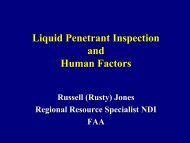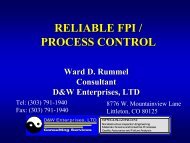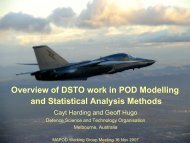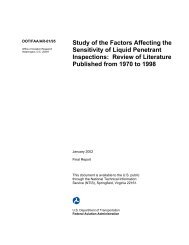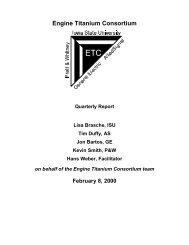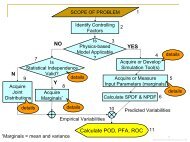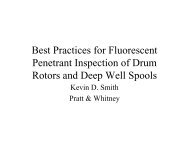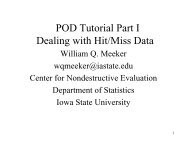Engine Titanium Consortium - Center for Nondestructive Evaluation ...
Engine Titanium Consortium - Center for Nondestructive Evaluation ...
Engine Titanium Consortium - Center for Nondestructive Evaluation ...
You also want an ePaper? Increase the reach of your titles
YUMPU automatically turns print PDFs into web optimized ePapers that Google loves.
include air drying, oven drying, and flash drying. Initial studies will utilize lcf blocks with final<br />
recommendations to be based on actual engine hardware. A matrix that defines the effect of drying<br />
parameters on detectability will be generated.<br />
Development of Best Practices Document: The final stage of the work will be generation of a best<br />
practices document that provides guidance to the OEMs and airlines and will allow <strong>for</strong> any<br />
necessary specification changes. An assessment will be made of the need <strong>for</strong> further work such as<br />
a <strong>for</strong>mal POD study and recommendations provided.<br />
Objective/Approach Amendments: Objective and approach were discussed and details were<br />
added to the approach in the February 2000 kick-off meeting.<br />
Progress (January 1, 2002 – March 31, 2002):<br />
The third and final testing session <strong>for</strong> this study was held at Delta February 4-7. Honeywell<br />
completed the “baked on” contamination process which lead to oxidation/scale, soot, and<br />
coke/varnish as specified by the team. All planned cleaning methods of the baked on<br />
contamination was completed at the Delta Airlines engine shop and at Northwest Airlines (wet-glass<br />
beading) both in Atlanta.<br />
Additionally, follow-up studies identified from results of the first cleaning run which occurred in<br />
October at Delta were made. These include additional samples with penetrating oil contamination.<br />
Some specimens were involved in various other cleaning trials including the use of vapor<br />
degreasing, acidic scale conditioner, acetone and permanganate.<br />
Part two of the cleaning studies at Delta included evaluation of the cleaning methods listed below<br />
<strong>for</strong> each of the contaminate types. In cases where unsatisfactory cleaning results were found <strong>for</strong> a<br />
particular contaminate/cleaning method combination, as determined by photometer brightness<br />
numbers, the sample was then cleaned by another method.<br />
• Oxidation of nickel specimens<br />
C3 – Alkaline De-rust Solution A<br />
C7a – Ultrasonic w/Alkaline De-rust Solution B<br />
B2 – Wet Glass Bead<br />
B5 – Aluminum Oxide 500 grit<br />
• Oxidation and scale of titanium specimens<br />
C2a – Alkaline De-rust Solution A<br />
C2b – Alkaline De-rust Solution B<br />
B2 – Wet Glass Bead<br />
B5 – Aluminum Oxide 500 grit<br />
• Soot on titanium<br />
C1 – Aqueous degreaser<br />
C2a – Alkaline De-rust Solution A<br />
Quarterly Report – January 1, 2002 –March 31, 2002<br />
print date/time: 6/6/2002 - 8:39 AM – Page 80



